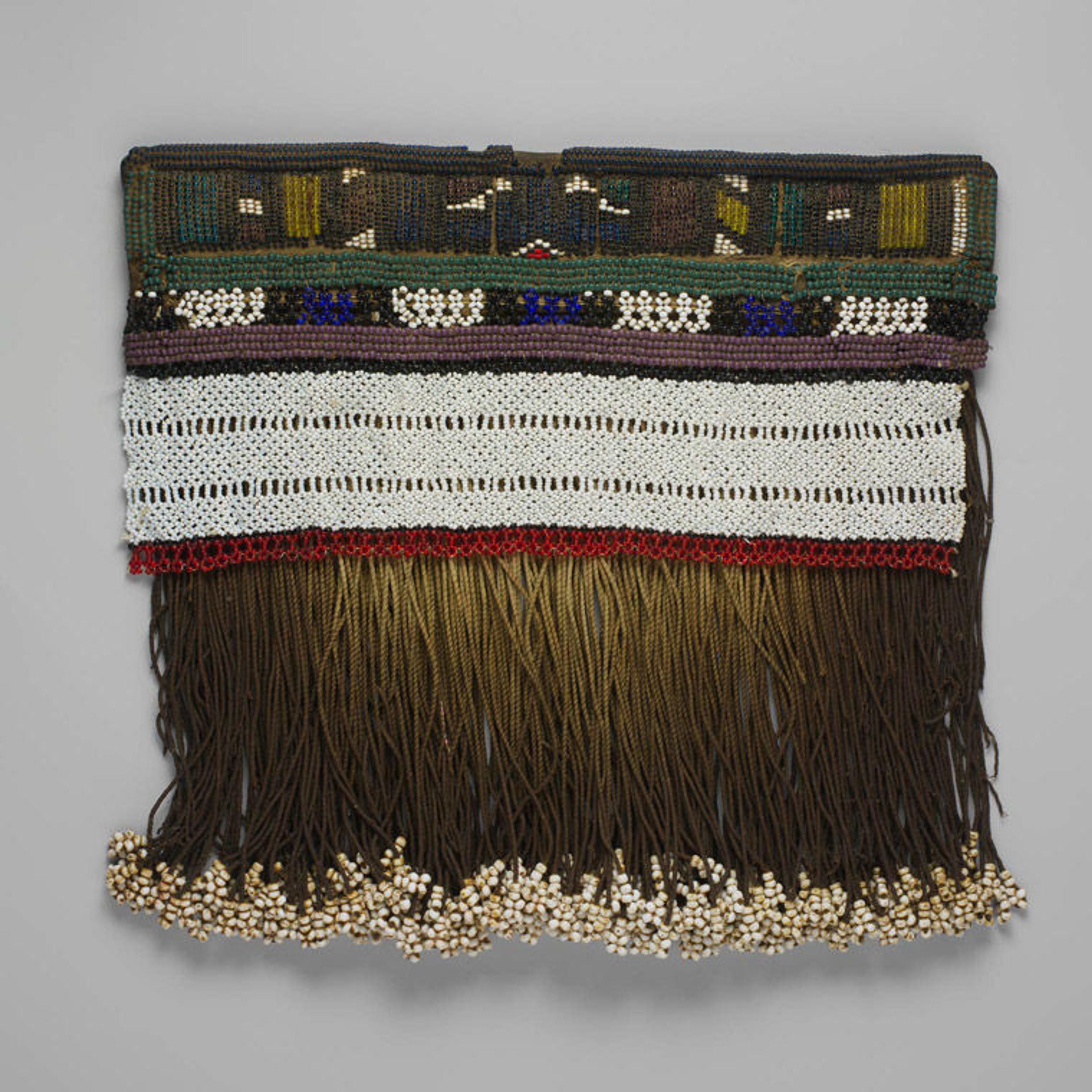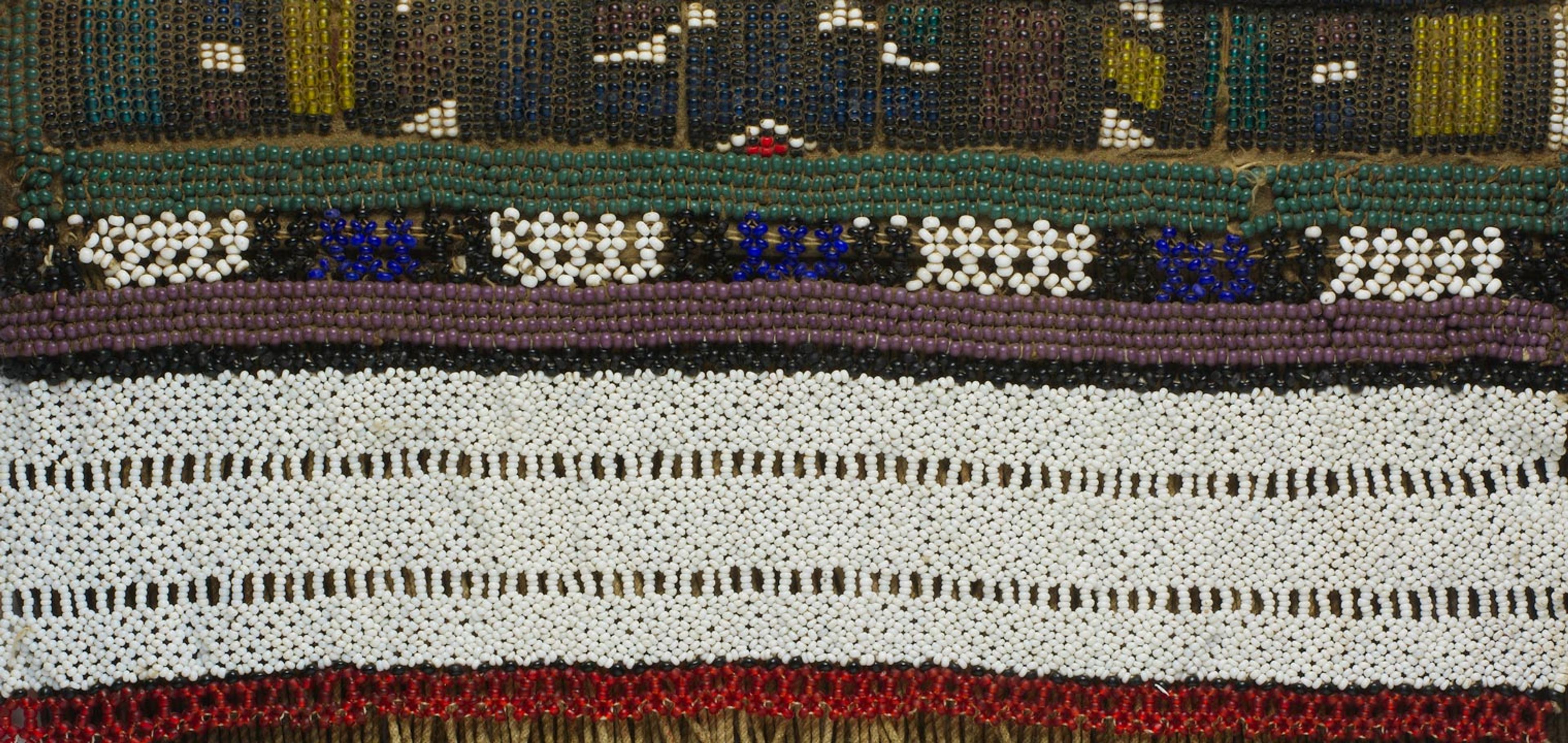
Detail view of a girl's apron (lighabi) made by the Ndebele peoples of South Africa
What exactly are beads?
Beads are most often small and spherical, made from materials that are desirable because of qualities such as color, shine, or rarity. By definition, beads are pierced with a hole so that they may be strung together or attached to a surface through various techniques, and they are some of the first decorative objects made by man: archaeologists working in the Blombos cave in South Africa recently uncovered forty-one marine shell (Nassarius kraussianus) beads made approximately seventy-five thousand years ago.[1]
The study of these small and precious objects provides a fascinating glimpse into the history of global trade, reminding us that people of different ages, places, and cultures may hold precisely the same objects dear. While this article primarily examines the use of glass beads in African art, it recognizes beads as a global medium of expression used for millennia, and therefore draws on objects from across The Met collection to further our understanding.
Beads made from glass have served as a basic item of trade since ancient times, and in the sixteenth century the circulation of glass beads grew exponentially with the development of world trade. The intrinsic desirability of the bead—as well as the ease with which a relatively large quantity could be transported as cargo—made them an essential item of trade. As these beads became an ever-more-popular commodity, the tiny island of Murano—located about one mile north of Venice, Italy—developed into the global capital of glass-bead manufacture. By 1606, there were 251 bead-making firms recorded in Murano alone, and Venetian glassmakers are thought to have made some one hundred thousand different varieties of bead types and designs for global export.[2]
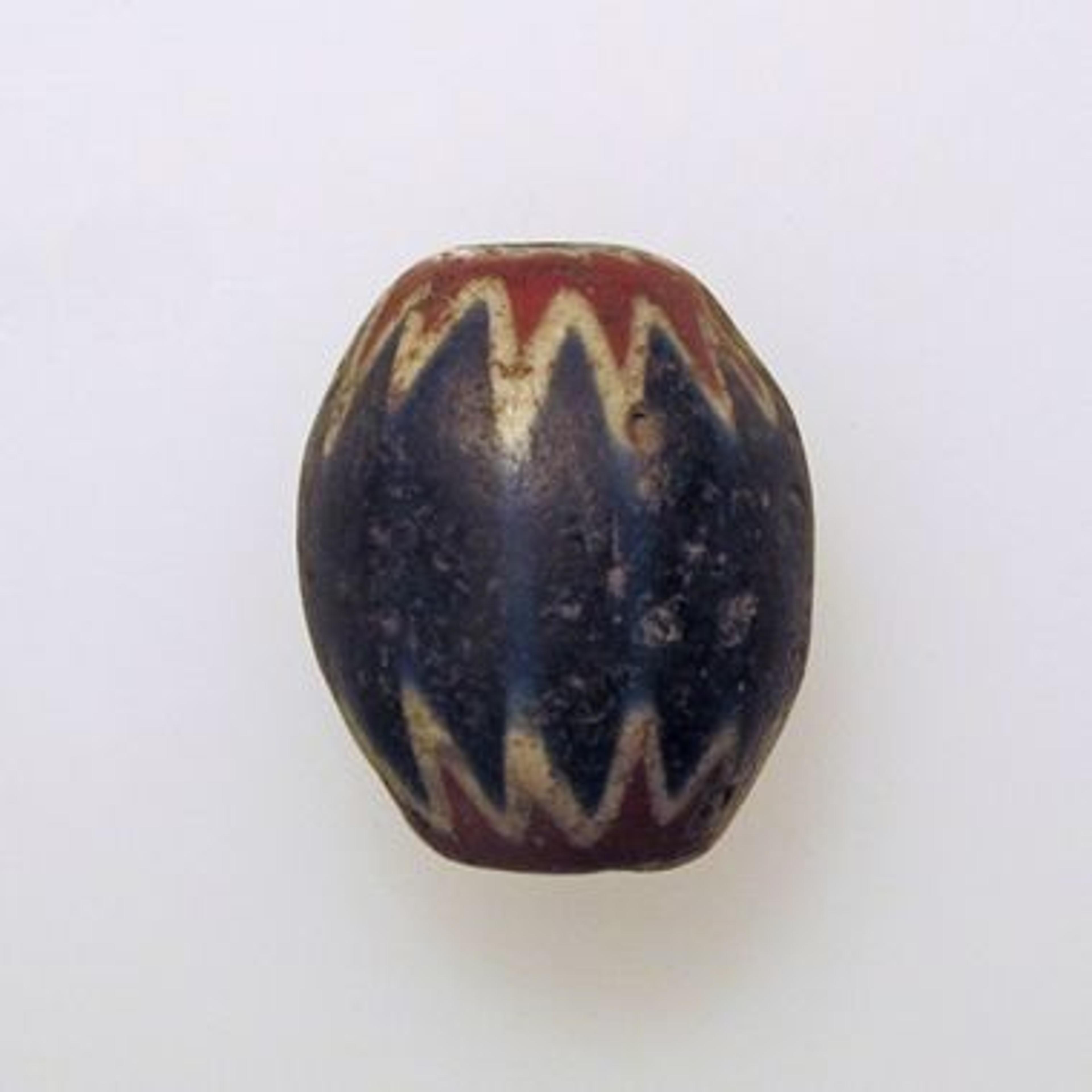
Left: Glass chevron bead. Venetian. Glass, Height: 1 3/16 x 15/16 in. (2.9 x 2.5 cm). The Metropolitan Museum of Art, New York, Gift of J. Pierpont Morgan, 1917 (17.194.1073)
Of these designs, one of the most celebrated is the chevron. These beads, which began to be produced in the late fifteenth century in Venice, were modeled on classical examples and traded throughout the world. They were extensively used by Dutch traders in West and Central Africa in the late fifteenth and early sixteenth centuries, where a single bead was—for a period—worth the life of a slave in the trans-Atlantic trade.[3]

King Charles II and Catherine of Braganza with allegories of the four continents, after 1662. British. Silk thread on silk, beads, H. 8 x L. 31 1/2 x W. 27 in. (20.3 x 80 x 68.6 cm). The Metropolitan Museum of Art, New York, Purchase, Mrs. Thomas J. Watson Gift, 1939 (39.13.1)
Glass beads were readily incorporated into many artistic traditions across the globe. Although used as a novel medium in seventeenth-century England, glass beads, likely imported from Italy, form the major decorative element of a spectacular basket created in celebration of the marriage of Charles II (1630–1685) to Catherine of Braganza (1638–1705) in 1661. The form of the basket relates to a Continental silver form of decorative basket associated with christenings of the same period, and it is likely that the use of glass beads would have been considered "exotic" in England at this time.
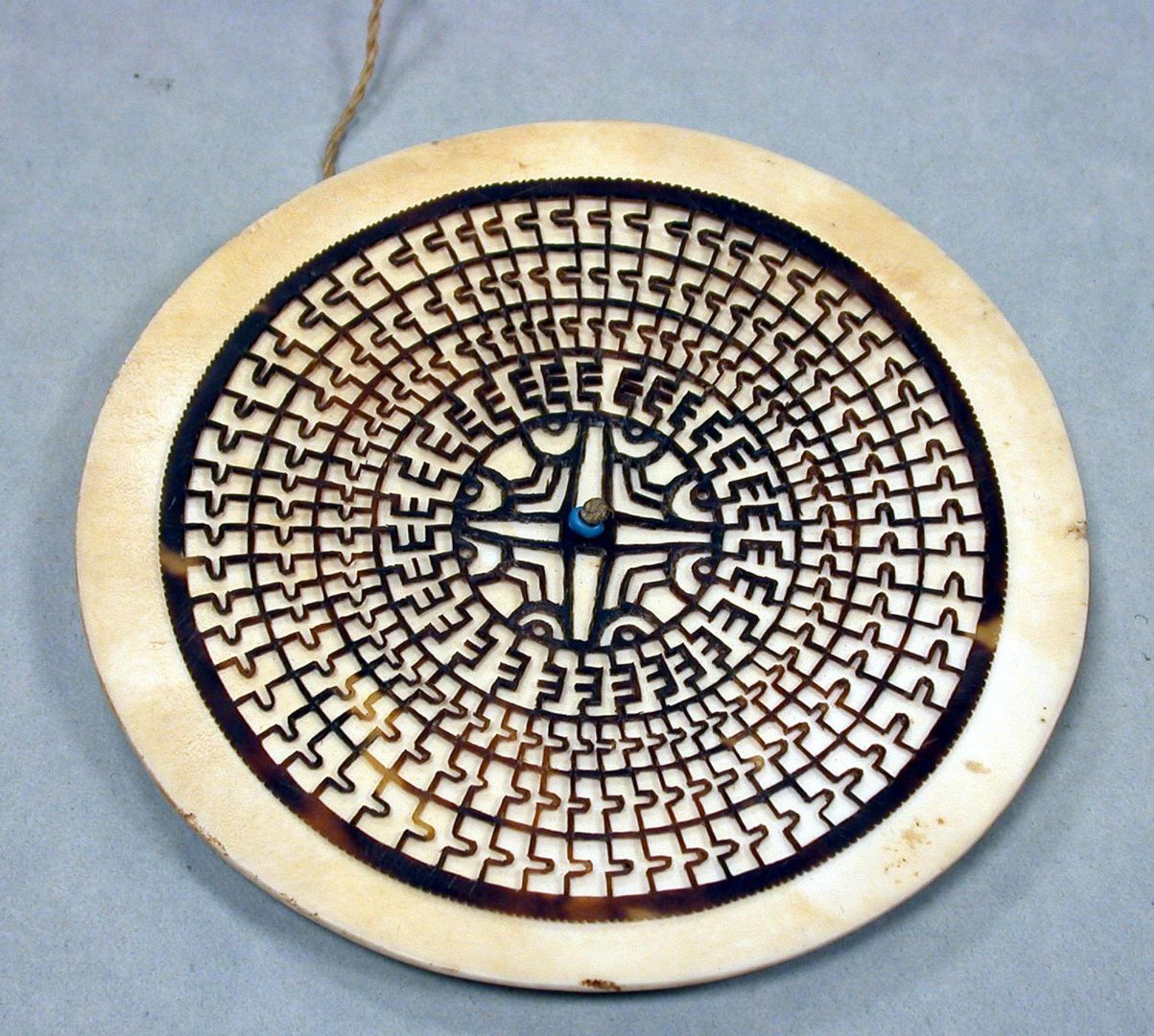
Pendant or head ornament (kapkap), late 19th–early 20th century. Solomon Islands. Tridacna shell, turtle shell, fiber, glass bead, Diam. 4 7/8 in. (12.4 cm). The Metropolitan Museum of Art, New York, Bequest of John B. Elliott, 1997 (1999.47.62)
An artist from the Solomon Islands working in the nineteenth century fashioned the pendant or head ornament (kapkap) shown above from Tridacna shell, turtle shell, and fiber, completing it by the addition of a single small bluish-green glass bead, likely of Venetian manufacture. While turtle and marine shell had long had a value in the region, colored glass beads were beautiful and desirable, an exotic material imported as if from another world. Why this single bead was so highly esteemed and given central focus in this striking composition is not hard to imagine: its color and texture, its value as a currency, the vast distance that it had traveled, and its strong associations with European culture all combine to increase its allure. The use of a single bead, moreover, indicates that the supply of beads to this culture was limited at this time, making the bead a rare object of adornment.
In many sub-Saharan African societies from the late fifteenth century onward, European glass beads replaced, or were used alongside, currencies made with indigenously sourced materials such as shell. As was the case in the Pacific, the absence of local glass-making technologies meant that societies as geographically diverse as the Zulu peoples of South Africa and the Kongo peoples of Central Africa believed that beads were produced in an ancestral world.[4] Invariably, the distribution of these precious things was managed by the elite in society, and so beadwork developed as an important expression of political authority.
Beginning in the late fifteenth century, coral beads imported from the Mediterranean constituted one of the principal commodities of European trade with the Kingdom of Benin, in present-day Nigeria. All coral and red stone beads entering the kingdom were deemed to be the private property of the king, or oba, who had the sole right to distribute them to his various dependents. The oba alone was permitted to wear a complete costume of beads that included—along with a crown and collar in beadwork—a beaded robe, and even beaded shoes. The status of other notables at court was evident in the relative lavishness of their beaded garments, which demonstrated in material terms their proximity to the bead-encased royal person.[5] In this setting, beads were used to decorate and enhance the human body, to transform it into something more than itself, a symbol of power and wealth.

Left: Head of an oba, 16th century. Nigeria, Court of Benin. Edo peoples. Brass, H. 9 1/4 x W. 8 5/8 x D. 9 in. (23.5 x 21.9 x 22.9 cm). The Metropolitan Museum of Art, New York, The Michael C. Rockefeller Memorial Collection, Bequest of Nelson A. Rockefeller, 1979 (1979.206.86). Right: Head of an oba, 19th century. Nigeria, Court of Benin. Edo peoples. Brass, H. 13 x Diam. 11 1/4 in. (33 x 28.6 cm). The Metropolitan Museum of Art, New York, Bequest of Alice K. Bache, 1977 (1977.187.37)
One of the essential elements in the cast brass portrait heads of the oba is the depiction of these coral beads. In some of the earliest portrait heads—dating to the sixteenth century—it is clear that coral beads are an important, if still relatively rare commodity. In one such portrait head from the sixteenth century (above left), the oba is portrayed wearing simple necklaces of beads, with a lattice network of beads worn over the head and strands of beads framing the face. In a later example dating from the nineteenth century (above right), the face is completely framed by beaded regalia, with necklaces piled on top of one another to reach just below the lip. Two beaded, wing-like projections on each side of the crown are accented with individual cylindrical beads and clusters on the lattice network, adding to the sense of the body being fully clothed in beadwork. Comparison of these two sculptures shows the marked increase in the use of beads over the period of just a few centuries.

Throne of Njouteu: Royal Couple, late 19th–early 20th century. Cameroon, Grassfields region. Bamileke peoples, Chiefdom of Bansoa. Wood, glass beads, cloth, cowrie shells, H. 64 x W. 29 1/4 x D. 26 1/2 in. (162.6 x 74.3 x 67.3 cm). The Metropolitan Museum of Art, New York, Purchase, Rogers Fund, Andrea Bollt Bequest, in memory of Robert Bollt Sr. and Robert Bollt Jr., and Laura and James J. Ross and Anonymous Gifts, 2014 (2014.256)
In the Grassfields region of Western Cameroon, the powerful rulers of competing states became major patrons of the arts, and beadwork likewise expressed power. Each chief, known as a fon, commissioned lavish palace complexes with regalia for themselves and members of their courts. A major element from fon Njouteu's treasury in the Chiefdom of Bansoa is the Throne of Njouteu, which depicts a king and his consort standing at the back of a circular seat supported by a leopard. The wooden sculpture was wrapped in a fine layer of locally woven raffia fabric, and a master in beadwork then applied thousands of glass beads onto this surface, using it as a three-dimensional canvas. The figures even wear necklaces of Venetian chevron beads in their own right. There are up to eight different kinds of bead used in this work—including the ubiquitous cowrie shell—indicating that this truly would have represented, as much as anything else, the treasury of a king.[6]
Nowhere in Africa were glass beads incorporated more seamlessly into indigenous artistic traditions than in Southern Africa, where beads were imported centuries before the arrival of Europeans. Glass beads were first traded across the Indian Ocean to the coast of East Africa, and then inland to important citadels such as Great Zimbabwe, between the seventh and tenth century A.D. Recent scientific analysis has revealed that these beads were made in Sri Lanka, South India, and the Persian Gulf, and were transported across the Indian Ocean by Arab and Swahili traders.[7] European glass beads were introduced to the region only in the sixteenth century by Portuguese and Dutch traders, and would have been exchanged for the most valuable products of the region: gold dust, copper, tobacco, ivory, rhinoceros horn, and tortoise shell.
Before the mid-nineteenth century, glass beads remained extremely rare in Southern Africa. A sophisticated art of dress and adornment was already in place, based primarily on the use of organic materials such as furs, hides, feathers, grass, seeds, and shells, with wealthy individuals also incorporating metals such as copper, brass, and iron.[8] By the last quarter of the nineteenth century, however, glass beads had either replaced or were used alongside these prized indigenous materials. Glass beads served as the ideal raw material for artistic traditions that were already dedicated to dress and adornment, with especially elaborate traditions in women's dress.

Girl's apron (lighabi), mid- to late 20th century. South Africa. Ndebele peoples. Glass beads, hide, H. 11 x W. 12 in. (27.9 x 30.5 cm). The Metropolitan Museum of Art, New York, Gift of Barbaralee Diamonstein-Spielvogel, 2009 (2009.500.5)
The Ndebele peoples of present-day South Africa and Zimbabwe use beadwork as a means of marking the different cultural stages of a woman's life. Items like a girl's apron (lighabi), the example above dating to the mid-twentieth century, were made to be worn by small children, most often girls. This particular skirt is formed from a stiff, folded canvas strip that would be tied around the waist, with an upper band of beads embroidered directly onto this surface. Hanging from this top band is a lace-like bead "cloth" constructed from individual bands of beadwork. This was intended to fall in front of the thick row of cotton cords threaded with white-seed beads that comprise the skirt itself, increasing the dimensionality of the garment and encouraging the play of light when seen in motion—an expression of youthful exuberance.

Married woman's apron (ijogolo), 19th–20th century. South Africa. Ndebele peoples. Leather, beads, thread, H. 29 3/4 x W. 26 1/2 in. (75.6 x 67.3 cm). The Metropolitan Museum of Art, New York, Gift of J. Camp, 1980 (1980.328)
A very different aesthetic is suggested by the married woman's apron (ijogolo) shown above, also made by an Ndebele master beader, probably in the late nineteenth or early twentieth century. Made for a married woman, a more refined, perhaps even dignified color palette is suggested by the background of white beads, at the center of which is an "H" shape in bright pink and green. Constructed from a large piece of goatskin historically prepared by the wearer's husband (canvas was later used, and then plastic), the top section of the leather is rolled over and packed full of dry grass. This would have been collected at a certain time of the year and had enduring associations with fertility, predating the introduction of glass beads.[9]

Woman's cape, 20th century. South Africa. Ndebele peoples. Wool, glass beads, brass bells, L. 69 1/2 in. (176.5 cm). The Metropolitan Museum of Art, New York, Purchase, Irene Lewisohn Bequest, 1978 (1978.16.2)
The additional flaps at the bottom would have covered the knees. The central panel is slightly longer—described as umama—and represents the "mother to the children," who in turn are symbolized by the side flaps.[10] Along with this apron, a married woman would have worn a cape decorated with extensive beadwork trim over her shoulders, covering her breasts. The "H" pattern seen on the apron is believed to symbolize the floor plan of the Ndebele homestead. This reminds us that when we see such works we must consider the context in which they were worn—in this case, as part of a total Ndebele work of art that had at its center the homestead, decorated with bold geometric mural painting.[11]

Collar (ingqosha), 19th–20th century. South Africa. Xhosa or Mfengu or Nguni peoples. Beads, fiber, buttons, leather, L. 19 in. The Metropolitan Museum of Art, New York, Purchase, Anonymous Gift, 1990 (1990.85.2)
For the Ndebele, beadwork and the expression of cultural identity through bold geometric design made a powerful political statement during the periods of colonialism and apartheid. Indeed, over the course of the twentieth century, beadwork in South Africa became increasingly associated with the expression of "traditional" precolonial African identity, and to wear beadwork was a political statement intended to evoke "an independent African past."[12] When Nelson Mandela wore the costume of a Thembu King—including leopard skin and a beadwork collar, similar to the collar (ingqosha) shown above—to his trial 1962, he stunned the courtroom. The wearing of this costume was seen as affront to the European suit and was part of Mandela's wish to delegitimize the authority of a European court in Africa.[13]
Left: Powder horn with shoulder belt, horn: ca. 1779–80; belt: probably early 19th century. Horn: Native American, possibly Penobscot; belt: European or Native American. Horn (cow), leather, linen, glass, L. 13 in. (33 cm); Diam. 2 3/4 in. (7 cm). The Metropolitan Museum of Art, New York, The Collection of J. H. Grenville Gilbert, of Ware, Massachusetts, Gift of Mrs. Gilbert, 1937 (37.131.16a; 39.87b)
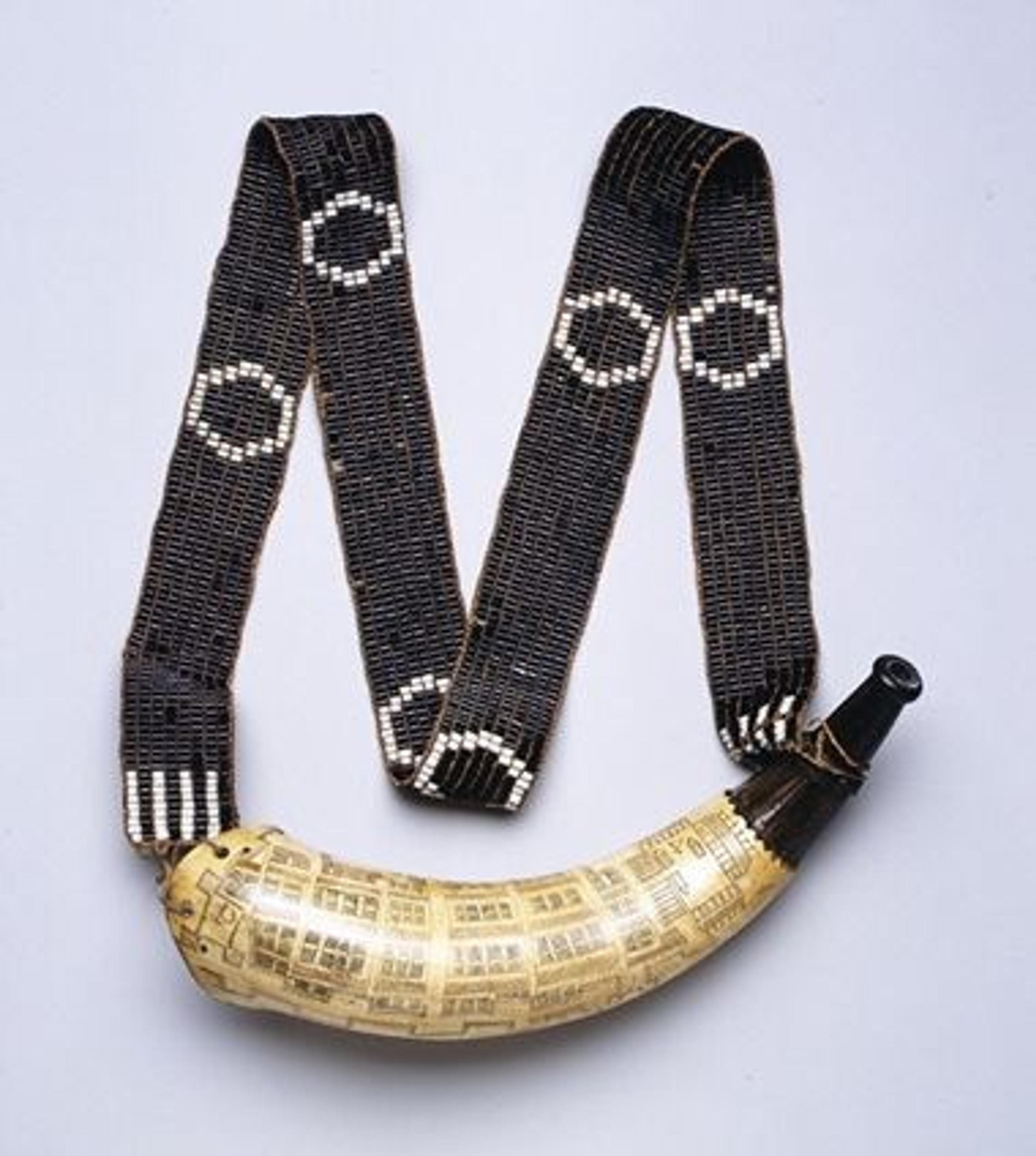
The same kinds of European-manufactured glass beads transported to Africa and Oceania also went to North America, and shipments to the United States during the 1880s amounted to six million pounds of beads a year.[14] As in Africa, glass beads were used in place of indigenous materials, replacing shell beads such as those previously used to make wampum belts for millennia, and the indigenous tradition of quillwork, whereby colored porcupine quills were beaded onto leather.
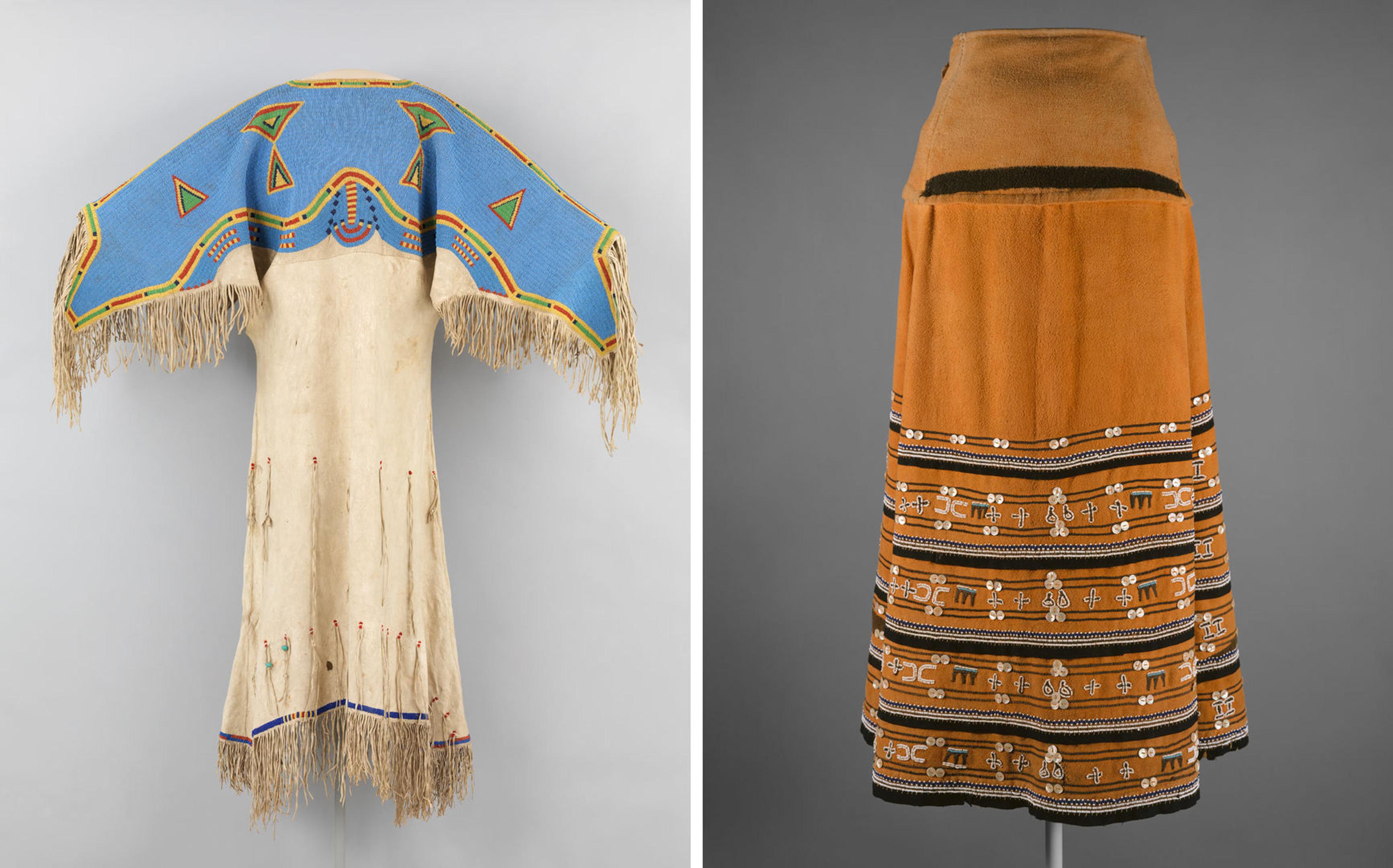
Left: Woman's dress, ca. 1880. United States. Sioux (Teton). Native-tanned leather, glass beads, L: 49 in. The Metropolitan Museum of Art, New York, Gift of Charles and Valerie Diker, 1999 (1999.484.4). Right: Skirt (isikhakha or umbhaco), 20th century. South Africa. Xhosa or Mfengu peoples. Cotton, wool, glass beads, shell buttons, ochre pigment, W. 75 1/2 x L. 37 1/4 in. (191.8 x 94.6 cm). The Metropolitan Museum of Art, New York, Purchase, Gilbert and Roda Graham Gift, 1993 (1993.373)
Because beads, especially seed beads, had an identical form, similar beadworking techniques were employed across cultures and continents. The Sioux woman's dress (above left), for example, is fashioned using similar techniques to those used to make the skirt (isikhakha or umbhaco) by the Xhosa peoples of South Africa (above right).
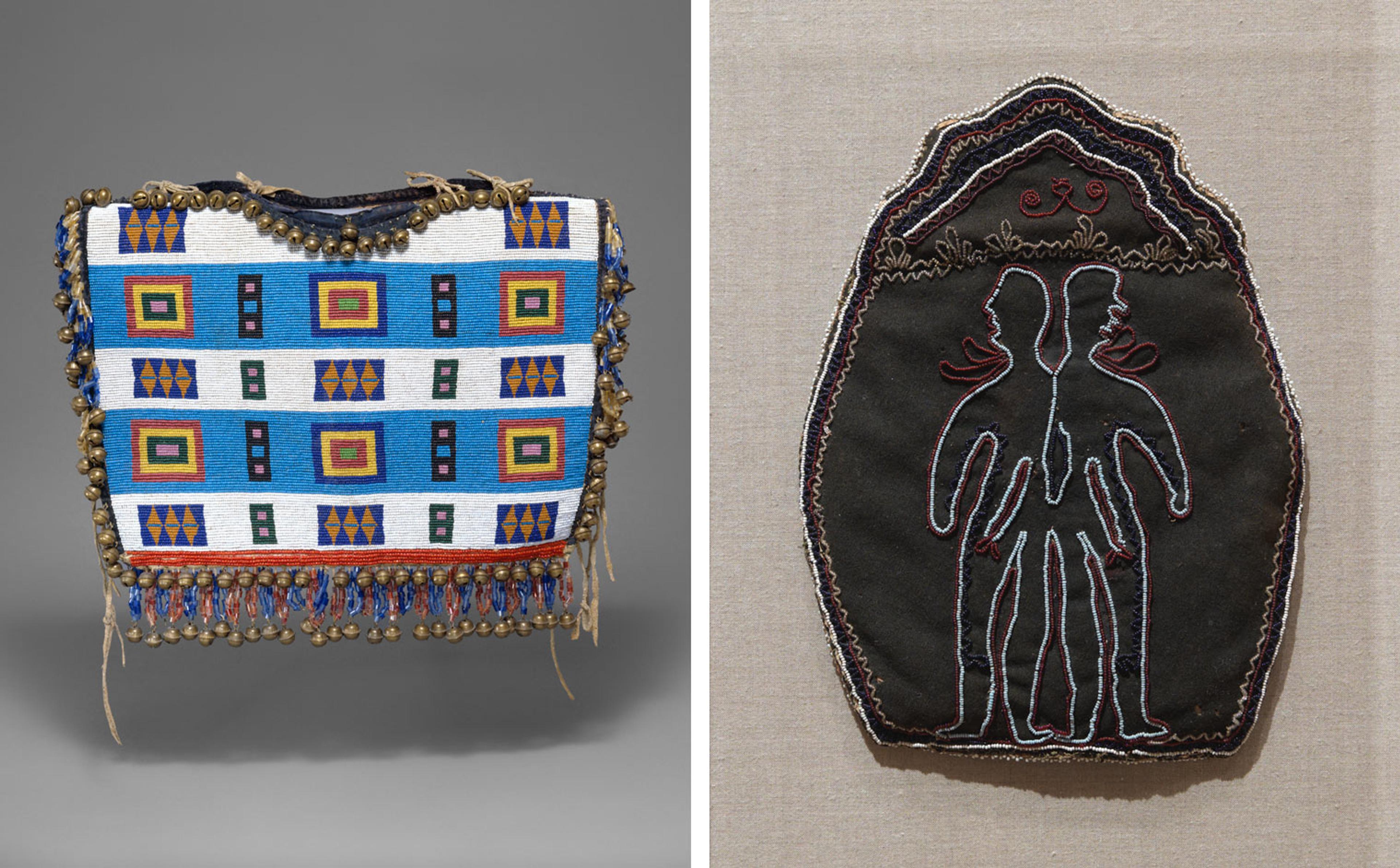
Left: Girl's cape, 1890–1905. Canada, Alberta. Stoney. Glass, cotton, metal, Native-tanned skin ties, H. 13 1/2 x W. 15 in. (34.3 x 38.1 cm). The Metropolitan Museum of Art, New York, Ralph T. Coe Collection, Gift of Ralph T. Coe Foundation for the Arts, 2011 (2011.154.115). Right: Pouch, first quarter of 19th century. Made in New York. Native American, Haudenosaunee/ Iroquois. English wool, cotton, silk, glass seed beads, 8 1/4 x 8 in. (21 x 20.3 cm). The Metropolitan Museum of Art, New York, Gift of Charles and Valerie Diker, 2016 (2016.738.3)
The technique of two-bead edging, whereby two beads are used to make a decorative edge, is employed both by the Ndebele artist in finishing off the cords of the young girl's skirt described above, and in another example by an Iroquois artist, to finish the edge of a pouch (above right) sometime earlier in the nineteenth century. In another example, the patterns seen on a nineteenth-century Stoney girl's cape from Canada (above left) are reminiscent of the kind of patterning one might find in Southern African beadwork, suggesting that certain kinds of geometry may be inscribed in the form of the bead itself.
The seamless inclusion of glass beads into indigenous artistic traditions across the globe demonstrates their undeniable versatility and universal appeal. Focusing on the humble and venerable bead reveals commonalities rather than differences between world cultures.
The author expresses special thanks to Associate Curator Yaëlle Biro and Conservator Christine Giuntini, both of the Department of the Arts of Africa, Oceania, and the Americas, and Curator Melinda Watt, formerly of the Department of European Sculpture and Decorative Arts, for sharing their insights and expertise throughout the development of this article.
Notes
[1] "Shell Beads from South African Cave Show Modern Human Behavior 75,000 Years Ago," National Science Foundation, April 15, 2004, https://www.nsf.gov/news/news_summ.jsp?cntn_id=100362.
[2] Lois Sherr Dubin, The History of Beads: From 100,000 B.C. to the Present (New York: Abrams, 2009), 111. While Venice had a near monopoly on the glass bead market, there was growing competition in other areas of Europe from glass making centers in Germany, Holland, and Bohemia, who desired to enter this lucrative trade.
[3] John Picard and Ruth Picard, Beads from the West African Trade (Picard African Imports, 1986). See also, Christraud Geary, Things of the Palace: A Catalogue of the Bamum Palace Museum in Foumban (Cameroon) (Wiesbaden: Steiner, 1983), 88 and Dubin, The History of Beads, 111.
[4] See, for example, Edmond Dartevelle, Les N'Zimbu: monnaie du royaume de Congo (Brussels: Société royale belge d'anthropologie et de préhistoire, 1953) for a Central African example. For a Zulu example, see Allen Francis Gardiner, Narrative of a Journey to the Zoolu Country in South Africa Undertaken in 1835. (London: Croft, 1836), 164.
[5] Kate Ezra, Royal Art of Benin: The Perls Collection in the Metropolitan Museum of Art (New York: The Metropolitan Museum of Art, 1992), 23.
[6] For more examples on the beadwork of Cameroon, see Pierre Harter and Howard Opper, "The beads of Cameroon," Beads: Journal of the Society of Bead Researchers (1992).
[7] Marilee Wood, "Glass beads from pre-European contact sub-Saharan Africa: Peter Francis's work revisited and updated," Archaeological Research in Asia 6, (2016): 65–80.
[8] D.L. Jones, "Towards a Developmental Approach: South African Beadwork,” Newsletter (Museum Ethnographers Group) 9, (1980): 2–7, 2.
[9] Aubrey Elliot, The Ndebele Art and Culture (Cape Town: Struik Publishers, 1989), 20.
[10] Diane Levy, "Ndebele Beadwork" (PhD diss., University of Witwatersrand, 1989), 54.
[11] Natalie Knight and Suzanne Priebatsch, The Evolution of a Cultural Identity: Art of the Ndebele (Atlanta: Atlanta International Museum, 1998), 6.
[12] Andre Proctor and Sandra Klopper, "Through the barrel of a bead: the personal and the political in the beadwork of the Eastern Cape," in Ezakwantu: Beadwork from the Eastern Cape: 31 October 1993–29 May 1994, South African National Gallery, ed. Emma Bedford (Cape Town: South African National Gallery, 1993), 56–65, 57.
[13] Rita Barnard, The Cambridge Companion to Nelson Mandela (New York: Cambridge Univ. Press, 2014).
[14] Dubin, The History of Beads, 111.
